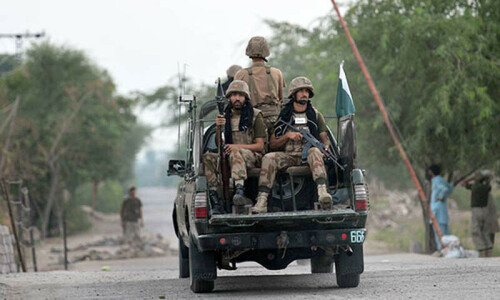
Serving Time: Pakistan’s Prisons Through the Ages
By Radha Shah/ Justice Project Pakistan
Justice Project Pakistan, Lahore
ISBN: 978-9692339315
286pp.
There are some people and institutions in Pakistan who restore one’s faith in humanity. One would go so far as to say that it is institutions like these that are keeping the dream alive, against all odds.
To mention just a few, there is the Edhi Foundation, The Citizens Foundation (TCF), the Saylani Welfare Trust, the Sindh Institute of Urology and Transplantation (SIUT) and this reviewer’s pet project: the Ayesha Chundrigar Foundation (ACF), which works for the voiceless in society and rescues animals suffering in appalling conditions.
Another name that must be added to this list is the Justice Project Pakistan (JPP), which is working for the systemic reform of the criminal justice system in the country.
JPP uses “strategic litigation” and an extensive advocacy programme to highlight Pakistan’s misuse of the death penalty, incidence of custodial torture and the living conditions of the incarcerated. The organisation publishes research and data, but has also used some innovative techniques to get its messages across; most recently, it created a multifaceted, interactive online campaign titled ‘This is (Not) a Game’, which shows how murder investigations can go very wrong.
In short, JPP is an organisation with clearly defined objectives and it has gained recognition for some recent campaigns on prisoners consigned to the death row. It has now moved into more serious — perhaps even academic — territory, with the publication of a book on Pakistan’s prisons.
An anthropologist examines Pakistan’s jails and their history, mainly through the eyes of the incarcerated
Serving Time: Pakistan’s Prisons Through the Ages is fundamentally an account of the experiences of 20 under-trial and convicted prisoners, across the four provinces of the country. But the book goes beyond that, with a detailed explanation of how the prison system evolved in the Subcontinent from the time of Mughal rule to the colonial era and beyond.
Authored by anthropologist Radha Shah, with editorial input from Sarah Belal, Aurangzaib Khan and Ali Haider Habib, the book’s text is interspersed with commentary on how the four provinces’ socio-political histories have shaped not only the manner in which Pakistan’s jails are run, but also the reasons why people are jailed to begin with. Suffice it to say that the circumstances that lead to incarceration are often murky.
The introductory chapter, ‘Prisons as Microcosms of Provincial and Federal Realities’, sets the tone for the book and also traces the history of criminal justice systems in the Subcontinent. The author quotes from Dr Satya Prakash Sangar’s well known 1967 study, Crime and Punishment in Mughal India, to refute the thesis of many British writers of the time, that is, that precolonial India was sorely lacking in administrative systems and was faced with “rampant criminality”.
Instead, as the author’s alternative sources show, local courts were run predominantly according to principles of Islamic civil and criminal law. Punishments were largely corporal, but also included terms of imprisonment, particularly for nobles. The colonial administration initially used forms of punishment more or less similar to the ones used during the Mughal era, often involving gruesome public spectacles.
Describing his introduction to Karachi Central Jail, Malik said: “When we enter the jail, there is a line of officers waiting, and they beat us from that gate to our ward with sticks, and we are running, hoping that somehow we can get to a place where we are no longer being beaten. When we get to the barracks, they stop.” — Excerpt from the book
But the British also introduced the concept of “corrective” incarceration facilities, largely with a view to reforming India’s “criminal classes”. These were basically tribes or groups of people who were marginalised in the caste system, and whose lifestyles — often nomadic — did not conform to the British idea of what a settled population should look like.
This tendency to pre-suppose characteristics of the population by geography is, according to the author, what dictates how modern Pakistani police looks at criminality in different regions.
After a brief exposition of recent prison reforms, the main body of the text is laid out as five chapters, one each covering jails and the accounts of prisoners in the four provinces, and an additional one covering women prisoners.
The author has an interesting approach, where each chapter begins with a brief section on how the colonial authorities saw criminality in the province. Thus, in Punjab, the British had an issue with semi-nomadic groups who did not own property (who were clearly outcasts in a predominantly agrarian society), and it was primarily these “criminal tribes” who were jailed for one offence or the other. In modern times, according to the author, this translates into the incarceration of primarily marginalised groups and people from low-income households.
While the bulk of prisoners in Pakistan generally belongs to low-income groups, other factors also come into play in other provinces. In Khyber Pakhtunkhwa and the erstwhile Federally Administered Tribal Areas (Fata), for example, militancy and dissent feature prominently in criminal trials and investigations.
Balochistan is the only province where jails are not overcrowded, but these prisons also have little to no facilities, and rehabilitation or correction are not even on the agenda. Is this because Balochistan’s prisons are also filled with nationalists? One cannot say for sure, but that may indeed be a factor.
Prisons in Sindh — more specifically Karachi, which the book focuses on — house all manner of persons, from political activists to common criminals jailed for petty offences. But they also have some semblance of rehabilitation going on, notwithstanding that the author clearly has a poor opinion of the work, education and recreational facilities that she was eagerly shown by the prison authorities.
The most poignant sections of each chapter are the accounts of the prisoners. Their stories are tragic — such as the narrative of the Ahmadi prisoner in Punjab, jailed on blasphemy charges and largely confined to his cell, perhaps for his own safety; shocking — such as the appraisal by a political activist of conditions in Peshawar Central Jail; and heart-breaking — such as the portrait of a woman raising a special child in a Karachi jail.
But there is also the occasional glimmer of hope and the sense that some humanity is still alive, as can be seen from the story of the District Superintendent of Police (DSP) in Khyber Pakhtunkhwa, who arranged to send a small sum of money to a poor prisoner’s family every month, realising that the detainee had been forced to steal because of extreme poverty. Then there is the Christian prisoner who used the jail library to learn about his rights as a prisoner and demanded that the authorities build a small church for the incarcerated belonging to his community.
Aside from these few instances, though, Serving Time is a deeply depressing read. It is crucial, however, that its content is publicised as much as possible. If there is one point of detraction, it is that there’s a thread of academic discourse running through the writing — the very first chapter quotes from French philosopher Michel Foucault’s book Discipline and Punish — but it is not in the form of a well-defined thesis. Instead, wherever the author tries to be academic, there is less cogency and more a scatter of buzzwords.
It may have been better to stay with a simple narrative and leave the academic underpinnings to someone more qualified. Having said that, Serving Time is an important addition to the literature on criminal justice in Pakistan.
The reviewer is a researcher and policy analyst
Published in Dawn, Books & Authors, December 25th, 2022















































